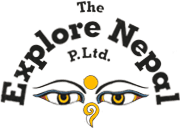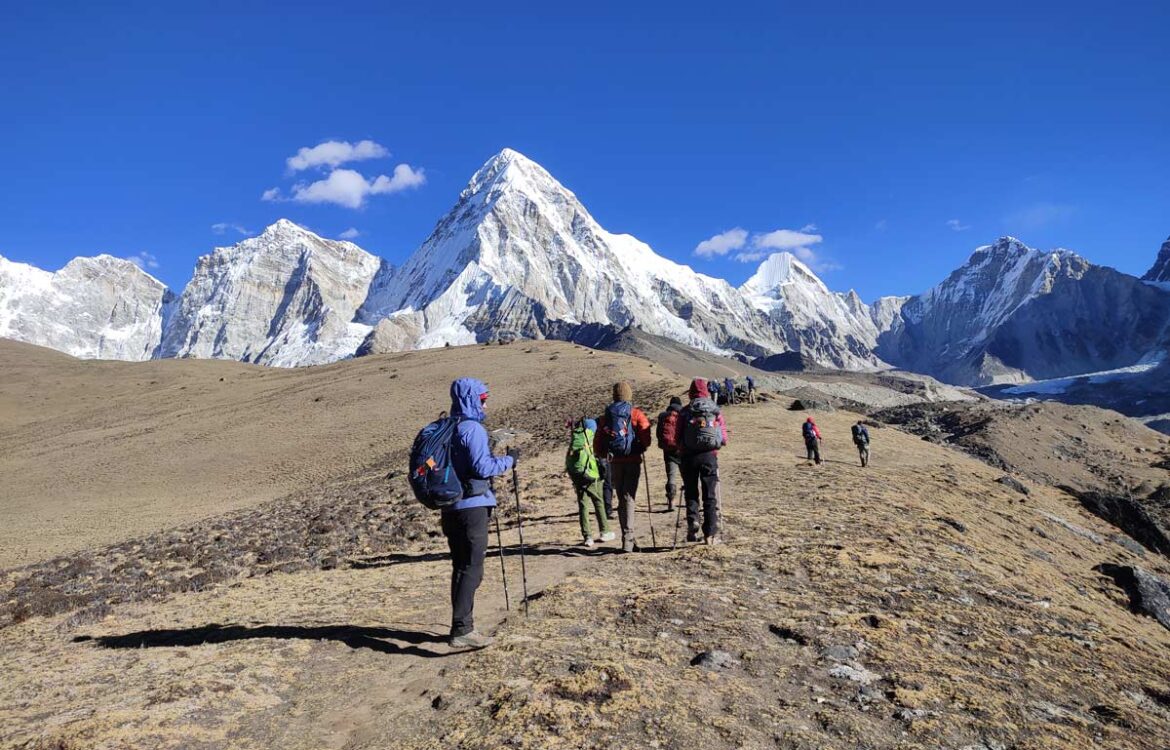
Best Months to Travel with Nepal Tour Packages: When to Visit Nepal
Planning a Nepal tour? The best time to visit can depend on where you’re heading – whether it’s the cultural hubs of the Kathmandu Valley, the lakeside haven of Pokhara, the jungles of Chitwan, or the high Himalayan trekking trails. Nepal’s geography ranges from tropical plains to soaring peaks, meaning the weather varies a lot by region and season. Don’t worry – we’ve got you covered with a breakdown of the best months to visit each popular destination. This guide will help you time your trip perfectly, so you experience each place at its very best.
(P.S. If you’re new to Nepal, stick around – this will give you a solid starting point. If you’re a repeat visitor, you might find a new season to fall in love with!)
Kathmandu Valley (Kathmandu, Patan & Bhaktapur) – Best in Dry Seasons
Nepal’s capital region is a year-round destination thanks to its mild climate and endless cultural sights. That said, the Kathmandu Valley truly shines in the dry months when the weather is pleasant and festivals are in full swing.
- Best months: October–November and February–April are ideal for Kathmandu Valley. In autumn (Oct–Nov), the monsoon rains have washed away dust, yielding crystal-clear Himalayan views from the city. Daytime temperatures are comfortable (around 20–25°C, 68–77°F) and the festive season is on – you might catch Dashain or Tihar, the biggest Nepali festivals, adding color and excitement to your visit.
Spring (Feb–Apr) brings mild warm days and blooming flowers (those purple jacaranda trees in Kathmandu are gorgeous in March/April!). The skies are generally clear in early spring, and it’s a great time to explore UNESCO Heritage Sites in Kathmandu, Patan, and Bhaktapur without weather worries.
- Months to be cautious while choosing Nepal tour package
Winter (Dec–Jan) in Kathmandu is dry and stable, with sunny days, but it can get chilly at night (temperatures can dip near freezing on cold nights). The upside? Fewer tourists and amazingly clear skies – on a January morning, you might spot snow-capped peaks from your hotel rooftop. Just pack a warm jacket for the evenings.
Monsoon season (June–August) is the least ideal time here. Expect frequent rain showers, humid days, and occasional flooding or muddy roads. Sightseeing is still doable between rains – and the temple courtyards look mystical in the rain – but you’ll need a good raincoat and patience for possible delays (and a sense of humor about dodging puddles!). The plus side of monsoon: the valley turns lush green, and you’ll have the historical sites almost to yourself.
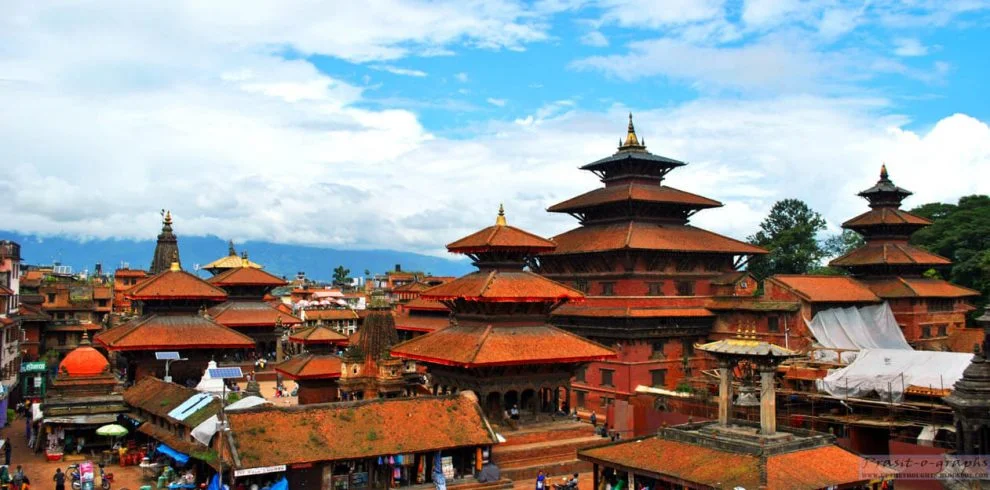
Travel Tips for Kathmandu tour packages :
- Plan around festivals: Visiting during October/November? Great choice – you’ll experience vibrant festivals. But remember that during major holidays like Dashain, some businesses close and transport tickets sell out. Book flights and hotels early if your trip coincides with festival weeks.
- Layer up in winter: Kathmandu’s daytime winter temps are comfy, but mornings and nights get cold and heating is not common in many hotels. Bring layers or thermal wear so you can still enjoy those early temple visits without chattering teeth.
- Come prepared in monsoon: Always carry an umbrella or rain jacket in June–Aug. Downpours can be sudden but often short. Use rainy afternoons to dive into museums, try a Nepali cooking class, or sit in a cozy café with some hot chiya (milk tea) and people-watch until the rain passes.
- Beat the pollution: In the dry winter and spring, the valley’s air can get dusty. A light face mask or scarf can be handy if you’re sensitive, especially when walking or riding through traffic. Early morning is the best time for clear air and mountain views before haze builds up.
Link : https://www.theexplorenepal.com/around-kathmandu-valley/, https://www.theexplorenepal.com/package/culturally-kathmandu/,
Pokhara – Best months for pokhara tour
Pokhara, the city of lakes and mountains, is all about those stunning Annapurna range views and laid-back lakeside charm. Like Kathmandu, Pokhara is good year-round, but timing your visit will affect whether you see the mountains or just clouds. Here’s when to go:
- Best months: October and November are hands-down the best in Pokhara. The monsoon rains are gone, the air is clean, and each morning the Annapurna Himalayas stand out sharp against blue skies. Picture yourself sipping coffee by Phewa Lake at dawn, watching the reflection of snow peaks – that’s Pokhara in late October. Daytime temps are in the pleasant mid-20s°C (70s°F).
Late September can also be nice if the rains retreat early, and December is cool but often clear (a fantastic time for unobstructed mountain panoramas with far fewer tourists around). Another great season is spring (March–April): weather is warm (mid to high 20s°C) and stable, perfect for boating on the lake or hiking to the World Peace Pagoda. In spring, the surrounding hillsides are alive with blooming rhododendrons and other flowers. The only trade-off is a bit of haze might start to appear by late April and the very beginning of May, partially obscuring some mountain views in the afternoons.
- Months to be cautious for Nepal tour :
Summer/monsoon (June–August) in Pokhara sees very heavy rainfall – it’s one of the wettest places in Nepal due to its location near the mountains. During these months, the sky often stays cloudy for days. You might wake up to misty lake views with mountains completely hidden behind clouds. Outdoor activities like paragliding or trekking often pause for rainstorms. Also, travel by road from Kathmandu can be tricky due to landslides on the highway in peak monsoon. That said, Pokhara in the monsoon has its own peaceful vibe: the tourist crowds thin out, the whole valley looks lush and green, and you can enjoy a quiet retreat with lower hotel rates. Just expect a more indoorsy trip – think reading a book with a view of rain on the lake, rather than epic sunrise hikes.
Winter (Jan–Feb) in Pokhara is generally mild. It’s chillier at night (single digits °C, around 40–50°F), but daytime temperatures often reach 15–20°C (60s°F) with sunshine. It’s actually a lovely time for scenery – the mountains are often visible and the air is crisp. Plus, around late December there’s usually a Street Festival in Lakeside to celebrate New Year, with food stalls and music, which can be a fun bonus if you’re there at year-end.
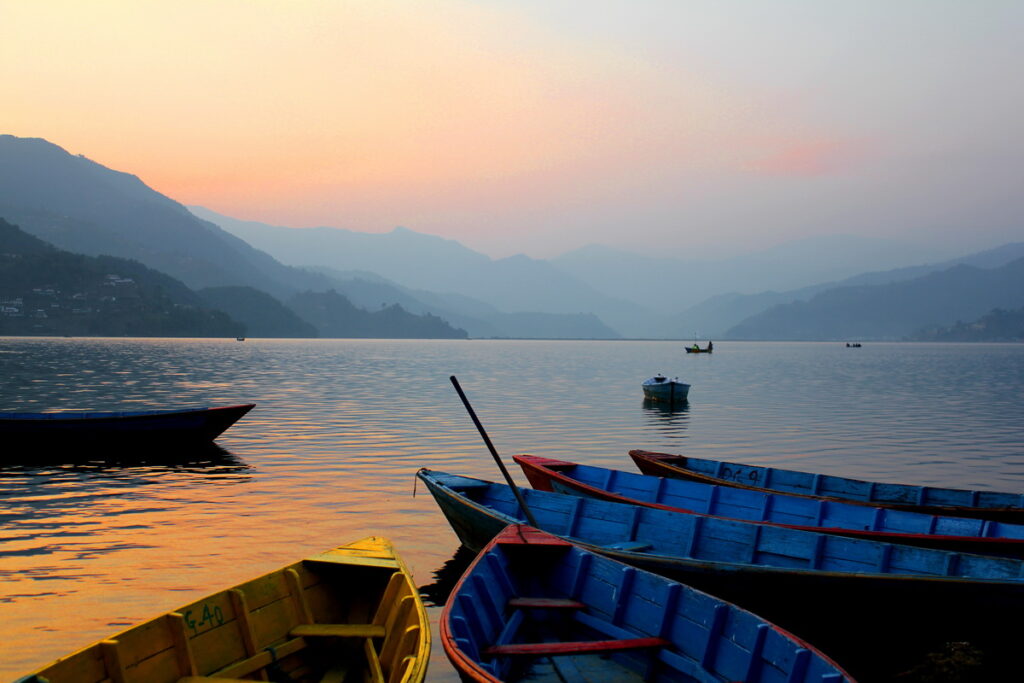
Travel Tips for Pokhara tour packages:
- Mountain views : If your goal is to see the Himalayas, plan at least 2-3 mornings in Pokhara. Even in the best months, sometimes clouds sneak in. Give yourself a few chances to catch that perfect sunrise from Sarangkot or Phewa Lake. Mornings (sunrise time) generally offer the clearest views before any haze or clouds form.
- Adventure timing: Pokhara is Nepal’s adventure sports hub (think paragliding, zip-lining, mountain biking). For the best experience, avoid the monsoon season for these activities – companies often shut or limit operations during heavy rains. October–November and March–April are ideal for adrenaline junkies, with mostly clear weather and safe conditions. Always book popular activities a day or two ahead in peak season so you don’t miss out.
- Stay lakeside & book ahead: During the autumn high season, Lakeside Pokhara gets quite busy. If you have your heart set on a particular hotel with a lake view, book early (especially for October/Nov). In contrast, during monsoon you can be more spontaneous and might snag discounts as hotels compete for the few tourists around.
- Monsoon essentials: Visiting in the rainy summer? Pack a good umbrella, quick-dry clothing, and insect repellent (Pokhara’s lush environment means mosquitoes, especially after rains). Also, be flexible with your itinerary – maybe schedule indoor attractions like the Gurkha Museum or yoga classes on days when it’s pouring, and save outdoor adventures for clearer spells. When the rain eases, the waterfalls around Pokhara (like Devi’s Fall) are at their most impressive volume!
(For more ideas on what to do, check out our Pokhara itinerary – it’s a handy guide to plan your stay, no matter the season.)
Chitwan National Park (Jungle Safaris & Wildlife) – Month for planning Chitwan tour packages
Switching gears from mountains to the Terai plains – Chitwan is Nepal’s premier wildlife destination, famous for jungle safaris, Bengal tigers, one-horned rhinos, and rich Tharu culture. Being a lower altitude tropical area, Chitwan has a hot, humid climate much of the year, so timing your visit is key to staying comfortable and maximizing animal sightings.
- Best months: The cooler dry season from October – March is the prime time for Chitwan. Specifically, November to early February offers pleasant daytime temperatures (20–25°C, 68–77°F) with cool mornings/evenings – ideal weather for exploring the jungle. The skies are usually clear and there’s virtually no rain, which means easier wildlife spotting by the rivers and waterholes.
December and January are wonderful for safaris: yes, the brisk morning air means you’ll want a jacket on that 7 AM jeep ride, but animals like rhinos and deer tend to come out to the open as the mist rises. By late February into March, it starts warming up again, but these months are still fairly dry – another excellent window to visit before the real heat kicks in. An extra perk: around February, park rangers typically cut back the tall elephant grass that grew during the monsoon, so by March the visibility in the jungle improves, making it easier to spot wildlife.
- Months to be cautious while planning a Chitwan tour packages
Late spring (April–May) in Chitwan gets very hot and sticky. Temperatures often soar above 30°C (86°F) and can approach 40°C (104°F) in May, with humidity building. Wildlife is still there (in fact, animals often cluster near water in the heat of April, which can sometimes make safari sightings exciting), but you’ll need to be prepared for sweat, sun, and possibly power outages (many lodges are comfortable but not all have strong AC). If you can handle the heat, carry electrolyte packets and schedule your safaris for early morning or late afternoon when it’s marginally cooler.
The monsoon (June–September) in Chitwan is off-season for good reason: relentless rainfall, high humidity, and lush overgrowth. The jungle becomes dense and buggy; trails turn to mud. Many lodges and resorts do maintenance or close during part of this season, and safari activities might be limited (walking safaris, for instance, are often halted during peak monsoon due to safety and to not disturb animals during breeding). Additionally, leeches make an appearance in the wet undergrowth – a surprise you probably don’t want on your vacation! Unless you’re a hardcore birder eager to spot migratory birds that arrive with the rains, it’s best to avoid the monsoon period for Chitwan. If you do go in summer, be ready for an ultra-green jungle experience, have flexible plans, and expect to spend downtime relaxing with a book during downpours.
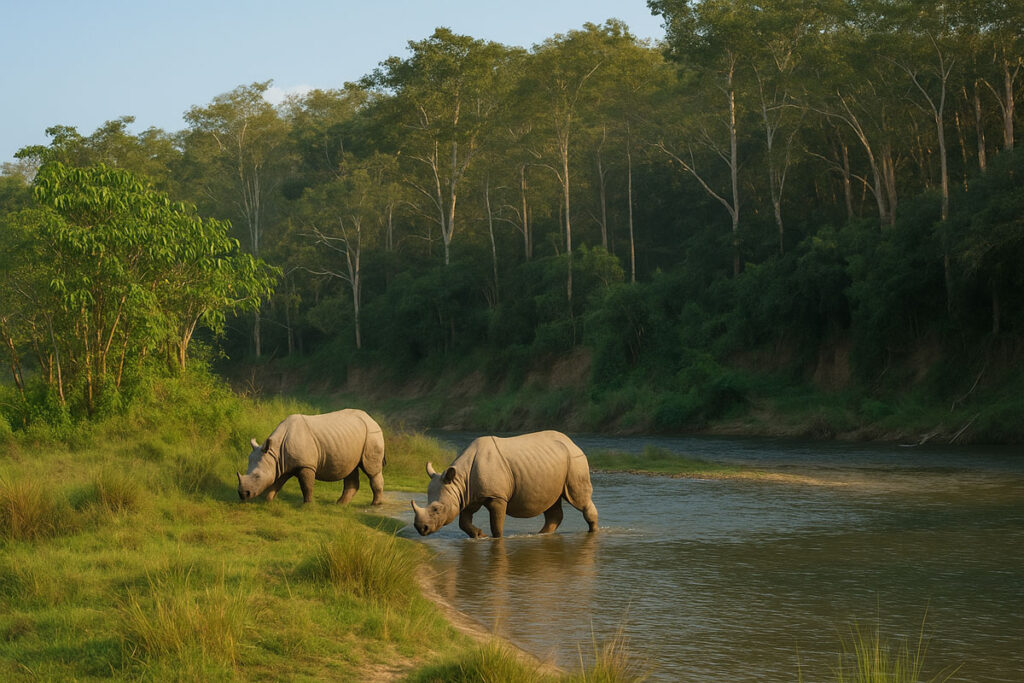
Travel Tips for Chitwan tour packages :
- Dress for safari success: Neutral colors (khaki, greens, browns) will help you blend into the environment and not startle wildlife. No need for full khaki safari suits, but avoid bright colors especially during walking safaris. Always wear long sleeves and long pants for morning and evening activities – they’ll protect you from mosquito bites (year-round) and prickly plants or the occasional leech (especially in wet season). A wide-brimmed hat and sunglasses are lifesavers under the Chitwan sun, and don’t forget high-SPF sunscreen even in winter (that midday sun can be strong).
- Wildlife-spotting timing: Plan on doing multiple safari activities over a couple of days. For example, do a jeep safari one afternoon and a guided nature walk or canoe ride the next morning. Early mornings (just after sunrise) and late afternoons are when animals are most active. Midday safaris might just have everyone (animals and you) seeking shade. By staying two nights, you can try different excursions – and if your first safari drives didn’t spot a tiger (they’re elusive!), you have another chance. Patience is key: this isn’t a zoo, so some luck is involved. The cool season gives the best odds since animals are out basking and visibility is good.
- Comfort in colder and warmer months: If you visit in winter, ask your lodge for extra blankets or a hot water bottle for your morning safari – sitting in an open jeep at dawn can be quite chilly (it’s a memorable kind of cold, with misty grasslands and deer shyness emerging – magical but brr!). Many lodges light a small campfire or provide hot tea to warm you up before you set out. By contrast, if you’re there in hot months (Apr-May), prioritize a place with a pool or at least air-conditioning to help you rest comfortably mid-day. Schedule a leisurely nap or reading break during the hottest afternoon hours, and do your exploring in the cooler parts of the day.
- Monsoon precautions: During monsoon season, bring serious insect repellent (Chitwan’s mosquitoes are legendary in the wet months). It’s wise to tuck your pants into long socks or use anti-leech socks if you go walking in the forest. Also, travel insurance is a must in case flooding disrupts your plans – sometimes heavy rains can temporarily cut off road access or cancel flights to Bharatpur. And keep expectations realistic: you may not see as much wildlife in the dense greenery, but you’ll definitely experience the jungle in its fullest, wildest form.
Link : https://www.theexplorenepal.com/package/nepal-culture-and-wildlife-tour/ , https://www.theexplorenepal.com/package/terai-wildlife-tour/
Trekking in Nepal – Best months for planning a trekking tour packages
For many, Nepal means trekking in the Himalayas. If you’re planning to hit the trails to Everest Base Camp, Annapurna, or any of the countless other epic treks, picking the right time of year is crucial. The mountains create their own weather, and conditions can make or break your trek’s enjoyment (and safety). Here’s the lowdown on the best trekking seasons for nepal tour packages:
- Best months: Autumn (Late September, October, November) is peak trekking season. The phrase “best time to trek in Nepal” is practically synonymous with October. During autumn, the air is fresh and clean after the monsoon, the skies are a brilliant blue, and the mountain views are as clear as it gets. Temperatures on the trail are moderate – warm days at lower elevations, and cold but manageable nights higher up.
It’s also a festive time: trekking through Sherpa or Gurung villages during the Dashain/Tihar festival period is a cultural bonus (you might see monastery celebrations or get offered festive treats by locals).
November is slightly colder than October, especially late in the month, but usually just as clear; by late November, trails start quieting down a bit.
While Spring (March, April, May) is the second great season for trekking. As the weather warms up after winter, mountain snows start to melt and high passes become passable again.
Early spring (March into early April) can still be a bit chilly at night in the high hills, but the daytime trekking weather is very pleasant. April is prime spring trekking: hillsides are bursting with red and pink rhododendron blossoms (a dream if you’re into nature photography), and days are longer than in autumn, giving you more daylight for hiking. You might encounter an odd rain shower or some afternoon clouds in spring, but mornings are often clear.
By May, it gets warmer and more humid – you’ll see more cloud build-up in afternoons and it’s the tail end of the trekking window for high altitudes (many trekkers avoid late May as it edges towards monsoon).
In summary: if you want guaranteed great weather and don’t mind crowds, October is ideal; if you prefer slightly fewer people and don’t mind bundling up a bit, late November or early December can be lovely; for blooming flowers and a lively spring vibe, March–April is fantastic.
Interlink : https://www.theexplorenepal.com/package/everest-base-camp-trek/ , https://www.theexplorenepal.com/package/annapurna-sanctuary-trek/,
- Months to be cautious
Winter (December – February) and Monsoon summer (June – August) are off-peak for trekking, but that doesn’t mean you can’t or shouldn’t trek – you just need to choose your adventures wisely. Winter is actually a beautiful time in terms of clarity – those winter skies are intensely clear and blue. The big issue is cold, especially at altitudes above 3,500 m (11,500 ft). High-altitude treks like Everest Base Camp or the Annapurna Circuit are still possible in December and even January, but you have to be prepared for sub-freezing temperatures at night and occasional snow on the trails.
The higher you go, the more likely you’ll encounter closed teahouses (many lodge owners take a break in the coldest months) and snow-blocked passes (for example, Thorung La Pass on the Annapurna Circuit is often closed by heavy snow in mid-winter). If you’re an experienced trekker or going with a guide, a December trek can be magical – imagine having tea houses almost to yourself and waking up to crisp mornings with views all to yourself that would normally have dozens of trekkers jostling for the perfect photo. Just pack serious cold-weather gear (down jacket, good sleeping bag, etc.) and allow extra days in case weather delays your progress. By February, conditions start to improve and some early birds hit the trails as temps very slowly rise.
Monsoon (June–Aug) is the most challenging time for classic treks like Everest, Annapurna, Langtang, etc. Heavy rain falls almost daily (mostly in the afternoon/evening), trails can get incredibly muddy and leech-infested, and clouds often obscure those postcard views of the peaks. Landslides can also occur, occasionally blocking trails or roads. Trekkers in monsoon have to be okay with getting wet and not seeing mountains for days. It’s not the top choice if it’s your once-in-a-lifetime Nepal trip. However, there are some treks that shine in the monsoon: regions north of the main Himalayan range lie in a rain shadow, meaning they get very little rain even in summer.
The Upper Mustang Trek (behind the Annapurna range) and Dolpo region treks are famous summer options – in these areas, summer is actually the best time, when the weather is mild and snow-free, and the forbidden kingdom of Mustang blooms with wildflowers under dramatic partly cloudy skies. These are more remote, specialty treks (with higher permit fees and logistics), but absolutely rewarding if you’re coming in the off-season and still want a Himalayan adventure. If you do trek in monsoon elsewhere, shorter hikes are the way to go – for example, doing a Ghorepani Poon Hill 4-5 day trek in July is doable if you’re okay with some rain; you’ll trek through mystical cloud forests and see surreal green landscapes (just maybe not a sunrise view from Poon Hill if it’s socked in by fog!). Always keep buffer days if traveling in monsoon, especially if your trek involves flights (like the flight to Lukla for Everest region – weather cancellations are common in summer).
Link : https://www.theexplorenepal.com/package/upper-mustang-trek/ , https://www.theexplorenepal.com/package/upper-mustang-jeep-tour/
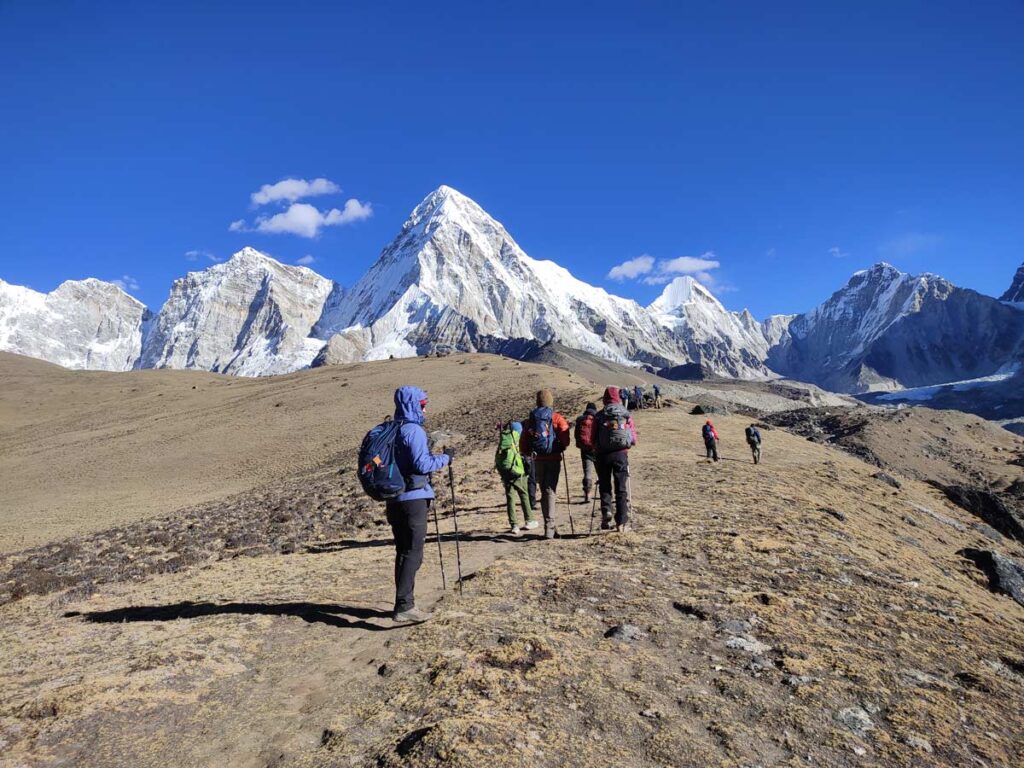
Travel Tips for Trekkers in Nepal:
- Plan ahead in peak season: If you’re trekking in the Autumn rush (Oct-Nov) or spring (especially April), be prepared for crowds on popular routes. Tea house lodges can fill up in places like Namche Bazaar (EBC route) or along the Annapurna trails. It’s a good idea to have a guide or porter who can forge ahead and secure a room, or be mentally prepared to share dormitory-style in a pinch. Also, domestic flights to trekking gateways (like Kathmandu to Lukla, or Pokhara to Jomsom) get booked up early in peak times – reserve them as soon as you know your dates. Popular treks like Everest Base Camp might benefit from a bit of schedule flexibility: starting a few days earlier or later than the absolute peak period can help you avoid the biggest crowds (and you’ll still get great weather).
- Gear up for the season: Your packing should adjust to the timing. For winter treks, bring high-quality warm gear (think four-season sleeping bag, down jacket, thermal base layers, good gloves and boots). For spring and autumn, layers are key – mornings and evenings are cool/cold, midday can be hot when hiking in the sun. For monsoon trekking, waterproof everything – jacket, pants, backpack cover, and use dry bags to keep clothes and electronics dry inside your pack. Quick-dry clothing and anti-leech socks (or just high trekking socks with gaiters) will make life more comfortable. A cheap poncho can be a savior to cover you and your backpack during sudden downpours. No matter when you trek, broken-in, sturdy hiking boots are a must (blisters don’t care what month it is!), and carrying some basic meds for stomach issues or altitude sickness is always wise.
- Stay informed and flexible: Mountain weather can be unpredictable. In shoulder seasons (late Nov or early Feb, or late May), you might get an unexpected storm or unseasonal weather. Always check the local forecast or with locals/guides before crossing high passes. It’s smart to build in an extra day or two to your trekking itinerary. That way, if you have to wait out bad weather (say, a heavy snowfall or rainstorm) or you get altitude sickness and need a rest day, you won’t be in a panic about missing your flight home. If everything goes smoothly, you get a free day in Kathmandu or Pokhara at the end to chill – not a bad deal!
- Consider a guide/porter: While many treks can be done independently in the main seasons, hiring a licensed guide or a porter (or both) can enhance your experience, especially if you’re going in the less common months. During winter, a guide can help break trail in snow and ensure you find open teahouses. In monsoon, they’ll know how to handle leech encounters or reroute you safely if a landslide blocks the path. Plus, you’ll be supporting the local economy. Even in peak season, a knowledgeable guide shares local insights and cultural context that can make your trek far more rewarding (and they’ll handle the logistics so you focus on the views!). Our trekking guides at Explore Nepal have trekked these paths in all conditions – they’ll happily share stories of Everest Base Camp Trek in a snowstorm or celebrating the Nepali New Year with villagers on the Annapurna Circuit.
(Need more specific trek info? Check out our detailed trek guides like the Everest Base Camp Trek guide or Annapurna Circuit trek guide, which include season-by-season breakdowns and tips. And if you’re eyeing a rare summer adventure, read up on the Upper Mustang Trek – a perfect monsoon-time trek!)
Inter link : https://www.theexplorenepal.com/package/ghorepani-poonhill-ghandruk-trek/ , https://www.theexplorenepal.com/package/langtang-gosainkunda-trek/,
Choose Your Season and Enjoy Nepal
Nepal is a country blessed with year-round beauty – there’s truly no bad time to visit, as long as you’re prepared for what each season offers. The key is to align your interests with the optimal destination timing. Love clear mountain vistas and comfortable days? Aim for that October-November window or springtime. More about cultural experiences and city exploration? Kathmandu has something going on at any time of year. Wildlife enthusiast? You now know winter is your friend in Chitwan. And if you’re a trekking aficionado, you might end up planning multiple trips to experience the Himalayas in different moods.
A little personal secret: some of my most memorable Nepal moments happened off-season – sipping chai by a fireplace in a Pokhara café during a July thunderstorm, having Bhaktapur’s ancient squares almost to myself on a misty January morning, or exchanging New Year greetings with sherpa friends on a brisk December trek. So whatever month you find yourself free to travel, Nepal will welcome you with open arms – you might just need an umbrella or a down jacket at times!
Happy traveling and happy trip-planning – Nepal awaits, in sunshine or rain, blossoms or snow. Whenever you choose to come, you’re in for an adventure of a lifetime.
